-
Node.js v20 Minimum Version Requirement
We're leveling up! FlowFuse now requires Node.js v20 or higher to run.
This change is effective from v2.24.0 onwards.
-
FlowFuse Expert Update
The FlowFuse Expert just got a major improvement: you can now start a conversation on the flowfuse.com homepage and continue it inside of FlowFuse and the Node-RED editor!
Now, when you use the Expert, you can bring your application-building instructions with you as you navigate.
This work involved major and important changes to the Expert UI, and brings us even closer to being able to build Node-RED flows using natural language inputs.
Give it a try!


-
SSO control over Session life
Customers on FlowFuse Cloud can now request custom Session Life times and Idle times. This allows the default times to be adjusted to match any in house policies that may be in place.
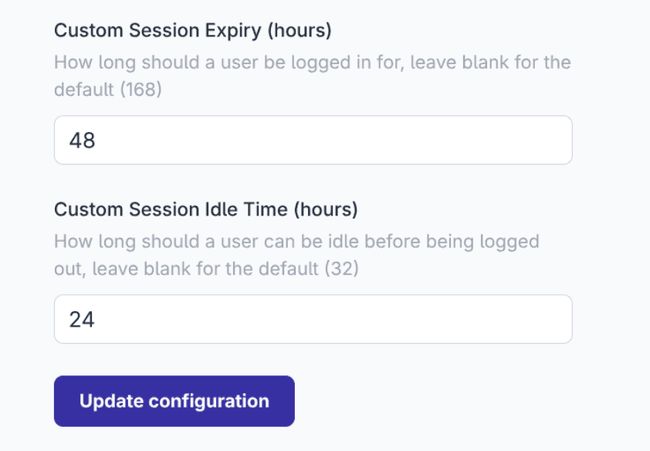
For existing FlowFuse Cloud customers please contact support if you would like to make changes to you existing configuration.
This will be available to Self Hosted customers in v2.24.0
-
Duplicate Instances Across Different Applications
As of today, you can now duplicate a hosted instance into a different application within your team.
It is a small (but important) improvement that just just makes things that little bit easier.
-
Easier Access to Bulk Device Group Management
Managing device groups for multiple Remote Instances is now easier to handle. Bulk management already existed but was difficult to use efficiently at larger scale.
This update refines that process. You can select multiple Remote Instances from the team or application remote instances pages and bulk assign them to device groups with fewer steps.
The improved workflow reduces friction when organizing devices by location, environment, or function.
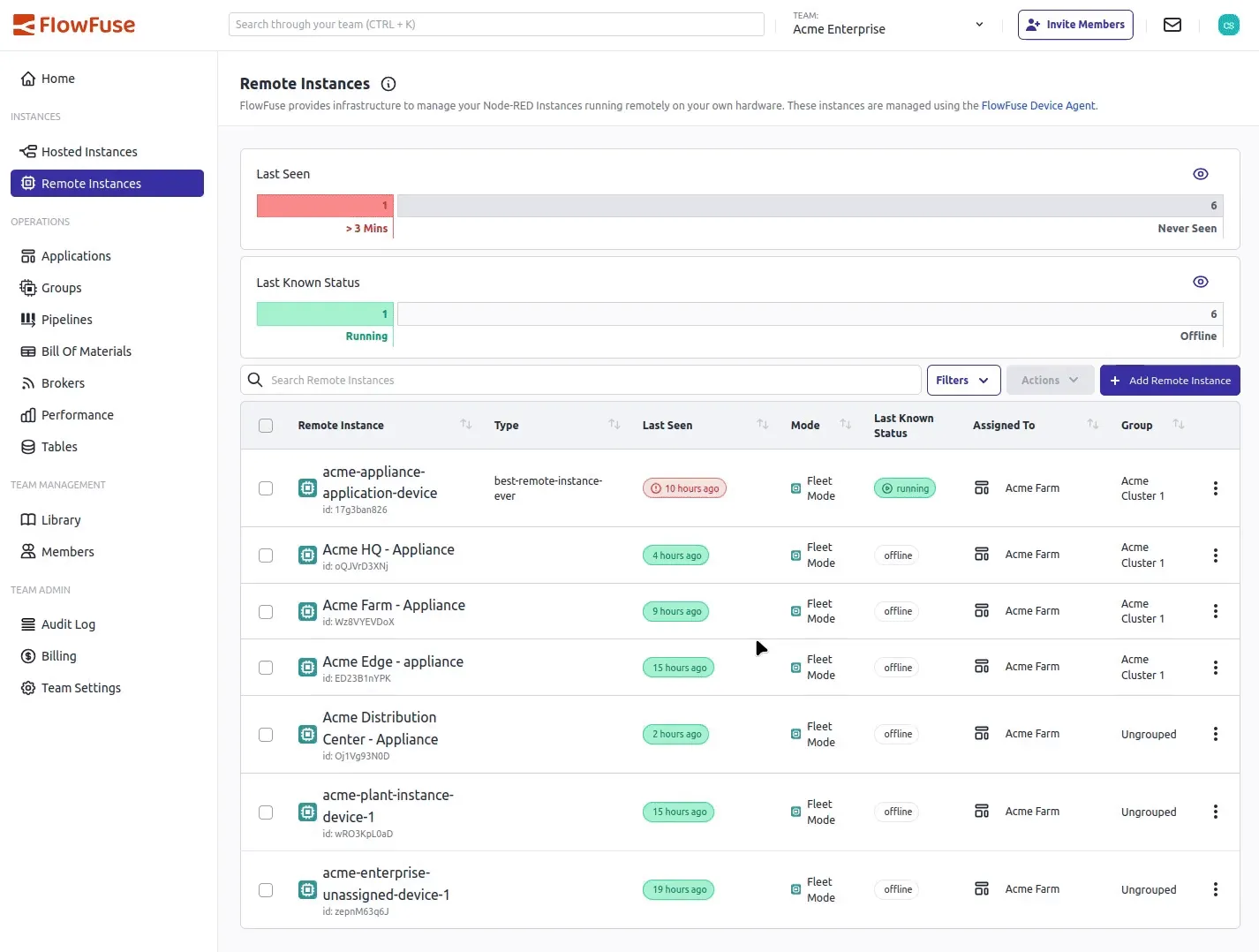
Bulk Device Group Management showing multi-select capabilities and group assignment options -
Device Group Management from Settings Page
Managing which device group your Remote Instance belong to just got a easier. Previously, if you wanted to move a device to a different group, you had to identify the group the Remote Instance belongs to, remove it, then find the group to assign it to, edit that group and add it. This was not optimal.
With this update, you can now see which group a Remote Instance belongs to directly from the overview page, and easily reassign it to a different group from the settings page without the hassle of searching through your entire group structure.
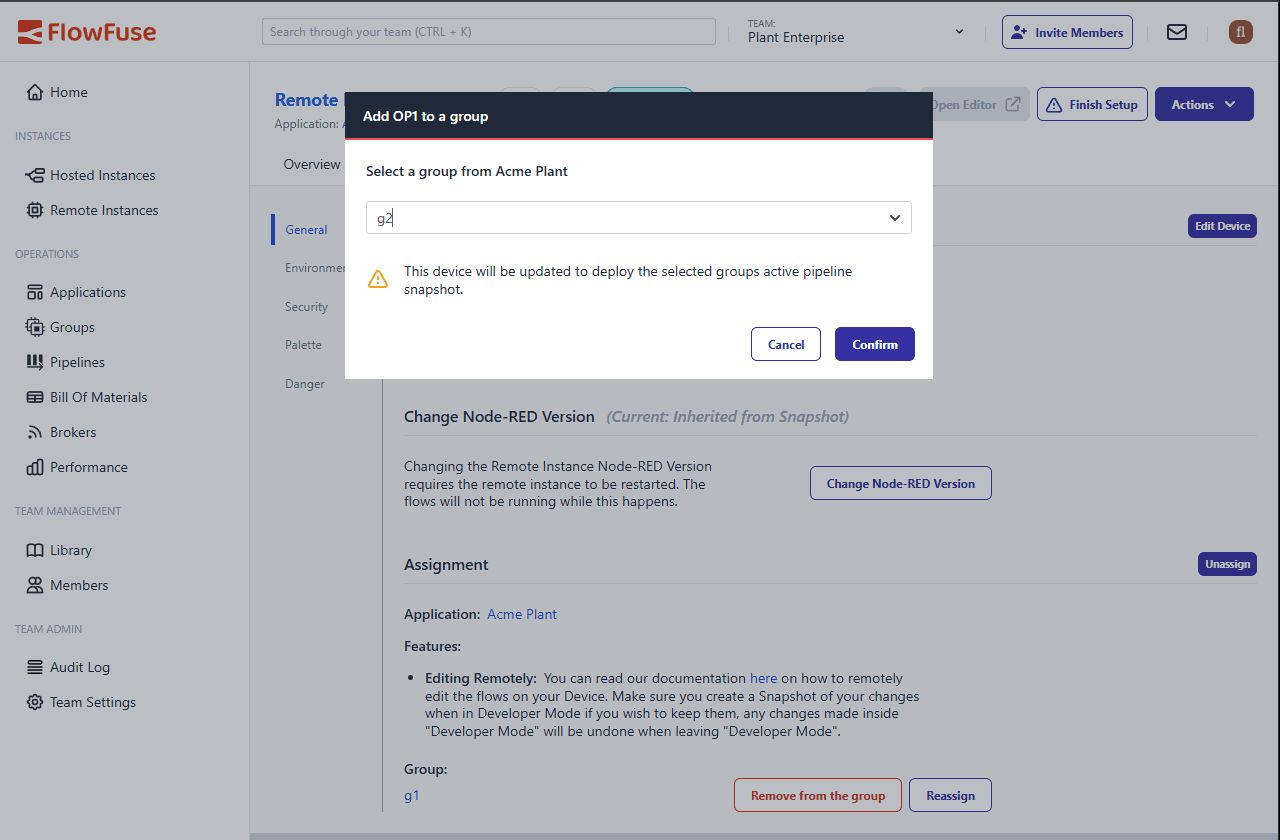
Device Group Management Interface showing current group and reassignment options -
Import flows during instance creation
Getting started with FlowFuse just became easier! When creating a new Node-RED instance, you can now import your existing flows directly during the setup process.
This new capability allows you to jumpstart your FlowFuse journey by bringing in flows you've already developed, whether they're from a local Node-RED installation, exported from another system, or shared by a colleague.
The import process is flexible and user-friendly:
- File upload: Simply select and upload a JSON file containing your flows
- Direct paste: Copy and paste flow JSON directly into a text area
- Live preview: See your flows rendered in real-time as you import them
The flows import step seamlessly integrates with the existing multi-step instance creation workflow. You can choose to start with a blueprint from our library or import your own flows - giving you multiple pathways to get productive quickly.
This enhancement is particularly valuable for teams looking to migrate existing Node-RED projects to FlowFuse or developers who want to quickly prototype with flows they've developed elsewhere.
Important considerations
When importing flows, keep these key points in mind:
- Flow validation: Imported flows aren't checked for validity, so invalid nodes may prevent your instance from starting
- Third-party nodes: External nodes aren't installed automatically but can be added once the instance is running
- Credentials and secrets: These aren't imported with flows but can be reconfigured after deployment
- Environment variables: Any required variables must be manually added to your environment after setup
Always verify the reliability of imported flows and avoid copying flows from untrusted sources.
To try it out, simply create a new instance and look for the new "Flows" step in the creation wizard!
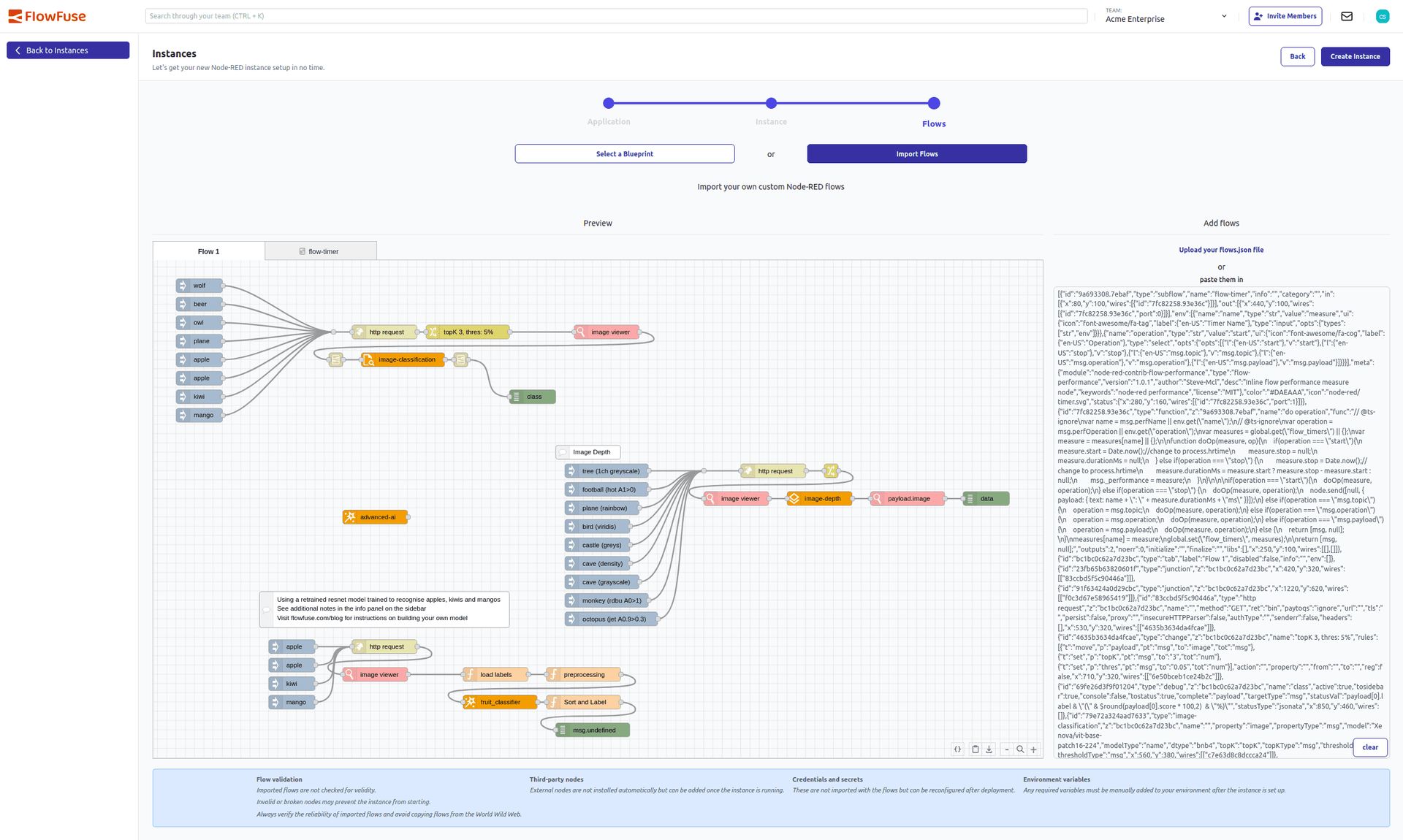
Demo importing flows when creating a Hosted Instance -
FlowFuse AI Nodes
We’re excited to introduce FlowFuse AI Nodes — a new contrib package that brings the ONNX Runtime to Node-RED.
What is ONNX?
ONNX (Open Neural Network Exchange) is an open format built to represent machine learning models. It provides an interoperable framework for AI developers to use models across different frameworks and tools.
Sounds great, right? So what does this mean for you?
You can now run pre-trained machine learning models directly within your Node-RED flows using the new FlowFuse AI Nodes. There are hundreds of pre-trained models available in the ONNX Model Zoo or from Hugging Face, covering a wide range of applications including image classification, object detection, natural language processing, Text to Speech, and more.
What can you do with FlowFuse AI Nodes?
In this first release, the FlowFuse AI Nodes package includes the following nodes:
- ONNX Inference Node: A bare node to run any model (including your own trained ONNX models). Just upload the model file and feed in the input data to get predictions.
- Image Classification Node: Classify images using pre-trained models like MobileNet, ResNet, or even use your own.
- Object Detection Node: Detect objects in images using models like YOLOv5, SSD, or your own.
- Image Depth Estimation Node: Estimate depth information from images.
With FlowFuse AI Nodes, you can easily integrate ONNX models into your Node-RED flows, enabling powerful AI capabilities without the need for extensive coding or machine learning expertise.
How to Get Started
FlowFuse customers can install the new AI nodes today via the Node-RED Palette Manager from the FlowFuse Nodes catalog
We have included example flows directly inside the package to help you get started quickly. Just hit
CTRL-Iin the Node-RED editor to import the example flows from the FlowFuse AI Nodes package.Additionally, we have created a blog post detailing how you can train a simple image classification model to accompany the advanced example flow included in the package. You can read all about it here: Deploy Custom-Trained AI Models: Using ONNX with Node-RED and FlowFuse
Screenshots
Here are a selection of screenshots of the built-in demo flows in action
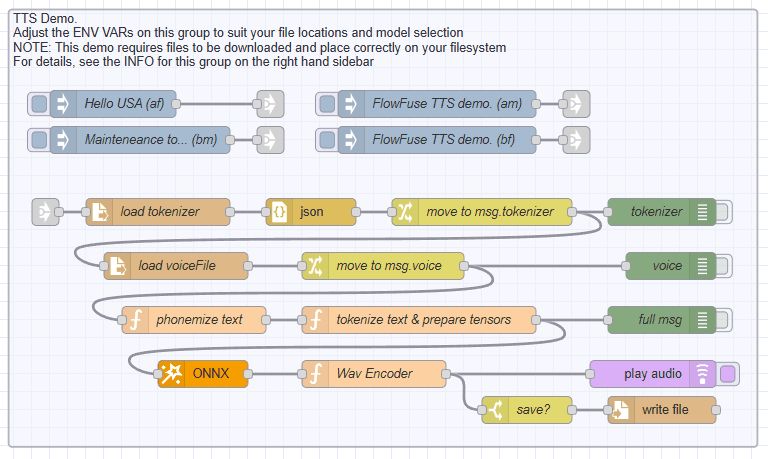
Running your own custom trained ONNX Model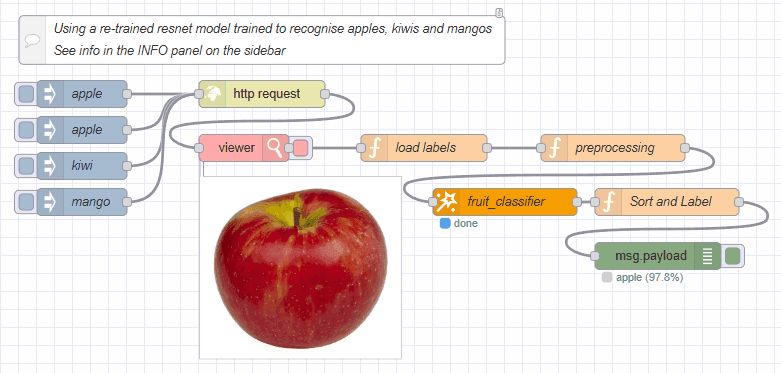
Using a Text-to-Speech-model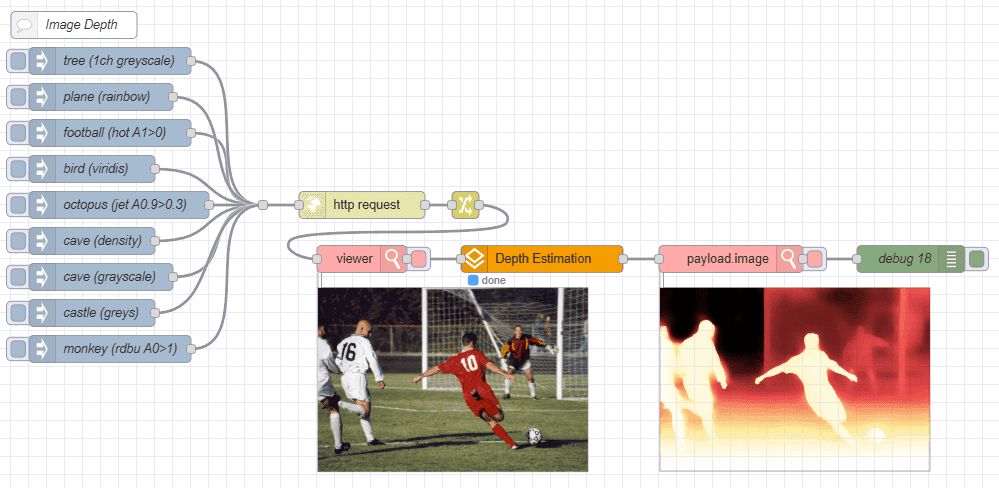
Performing Image Depth Estimation -
FlowFuse MCP Server Nodes
We’re excited to introduce FlowFuse MCP Server Nodes — a new contrib package that brings MCP Tools, Resources, and Prompts straight into Node-RED. With just a few nodes, you can design custom MCP-powered automations, connect dynamic resources, and return responses seamlessly in your flows. Whether you’re prototyping or extending integrations, these nodes make it faster than ever to put MCP to work in your applications.
Over the coming weeks, we’ll share use cases and demos to inspire you, but in the meantime, we’ve included some sample flows you can access directly in Node-RED via the import menu (
CTRL+I) and some additional links below.What is MCP?
The Model Context Protocol (MCP) is an emerging open standard for connecting AI models with tools and data sources in a structured way. It defines how prompts, resources, and responses should be exchanged, making it easier to build reliable and reusable AI-powered workflows.
Why is MCP important?
As AI adoption grows, developers need consistent ways to integrate models into real-world systems. MCP helps standardize this process, reducing boilerplate and ensuring interoperability across tools and platforms. With Node-RED support, FlowFuse makes it easier than ever for developers to experiment with MCP, build production-ready flows, and unlock the potential of AI-driven automation.
Screenshots
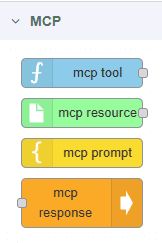
New MCP NodesFlowFuse customers can install the MCP Server nodes today via the Node-RED Palette Manager from the FlowFuse Nodes catalog
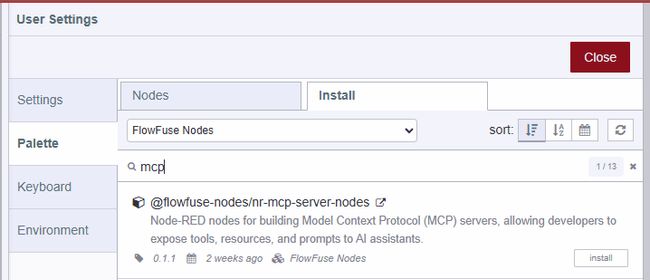
Additional links
-
Application-level access control for Enterprise teams
One of the super-powers FlowFuse brings is its role-based access control that gets applied across the team. This allows teams to have users with different levels of access to the Node-RED instances - from full editor access, to read-only access, to only being able to access the dashboards the instances create.
We've pushed this one step further today for Enterprise teams, allowing them to set a user's role on a per-Application basis. This finer-grained control gives teams more flexibility in how they can secure their resources.
For example, a team could create an Application dedicated to their production systems, with a limited set of users able to make changes - whilst having a Development application that is accessible to a broader group of user.
The roles for an application can be modified under the 'User Access' section of its settings. It shows what roles each user has for the application and where any application-specific overrides have been set. Here you can see I've reduced Ben to a Dashboard role for this application - sorry Ben!
As with managing the top level roles in a team, only Team Owners are able to modify the roles within an application.
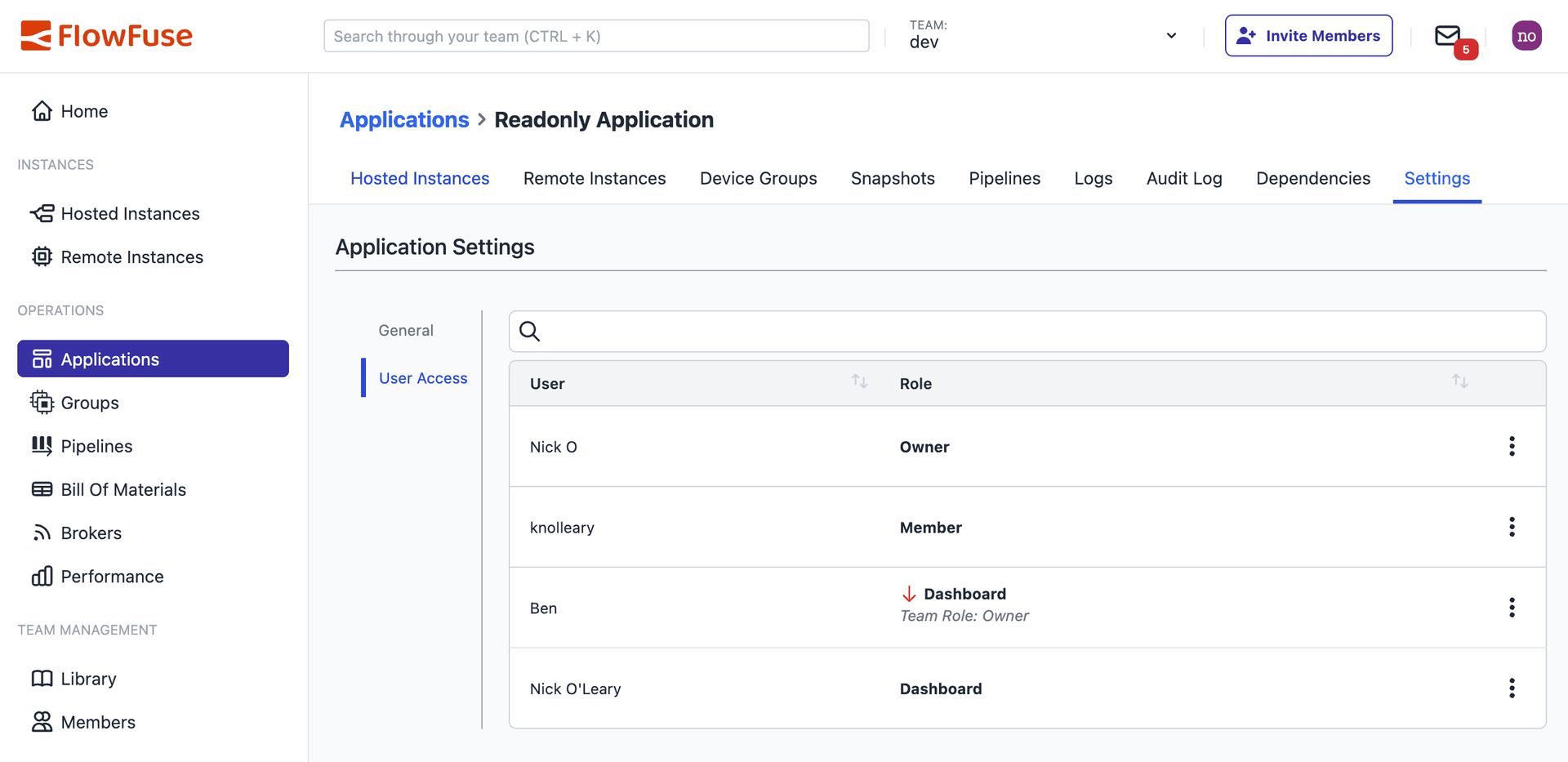
Application RBAC Settings -
Allow SSO groups to be shared with the Node-RED Dashboard
A new flag has been added to the SAML SSO configuration to allow a user's group membership to be included in the profile information included when FlowFuse Authentication is used with the Node-RED Dashboard v2.
Shown here is the content of the
_clientobject attached to messages generated by the Dashboard nodes.{
"user": {
"username": "ben-example_com",
"email": "ben@example.com",
"image": "https://forge.example.com/avatar/YmVu",
"name": "Ben",
"userId": "r3VG59G85J",
"role": "owner",
"SSOGroups": [
"FlowFuse",
"ff-development-owner",
"test_ff-development-owner_test"
]
},
"socketId": "NA7eDLuWbR6wmCpSAAAF",
"socketIp": "192.168.1.56"
}The new key
SSOGroupsincludes the list of Groups passed to the SSO configuration by the SAML backend and can be used by the Dashboard to control what information is shown to the user.More details about how to create mutli-user Node-RED Dashboards can be found here
SSO is available to Enterprise teams on FlowFuse Cloud. Contact support if you would like this feature to be enable for your team.
-
Capture Async API data from FlowFuse Team Broker
The FlowFuse Team Broker now includes automatically curated smart suggestions for the published payloads in each topic.
You can run this by simply toggling on the toggle found in the Topic Hierarchy view. This will run for 24 hours.
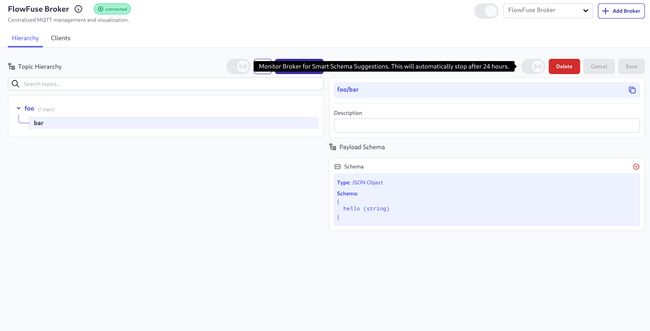
Our agent will monitor for any payloads published on your broker in that time, and offer smart suggestions on data structure found. You can review these suggestions with the FlowFuse user interface, and confirm them where appropriate.
Once confirmed, the Async API documentation can be viewed by clicking on the "Open Schema" button. This means that your whole team can be aligned when building with your UNS.
This functionality was previously only available to 3rd party MQTT brokers using the MQTT Schema Agent, it is enabled on FlowFuse Cloud and will be available to Enterprise Licensed Self Hosted customers from v2.22.0.
-
No more @flowforge/flowforge-device-agent releases
When we changed company name from FlowForge to FlowFuse we continued to publish the Device Agent under the old package name
@flowforge/flowforge-device-agentas well as the new package name@flowfuse/device-agent.The current version 3.6.1 will be last release under the old package name.
The latest version can be found on npmjs.org here.
To upgrade please uninstall
@flowforge/flowforge-device-agentusingnpm uninstall -g @flowforge/flowforge-device-agent(You may need to prefix this command with
sudoon Unix platforms)and install
@flowfuse/device-agent.npm install -g @flowfuse/device-agent(again you may need to prefix this with
sudoon Unix platforms)The replacement package includes a migration binary called
flowforge-device-agentwhich can still be used to start the new package. -
Streamlined Snapshot Management
We’ve redesigned how you interact with Hosted Instance snapshots by bringing all related actions into one place.
Instead of jumping between different menus, you can now manage everything directly from a single consolidated view.This update keeps all existing functionality, but makes it easier and faster to find and use.
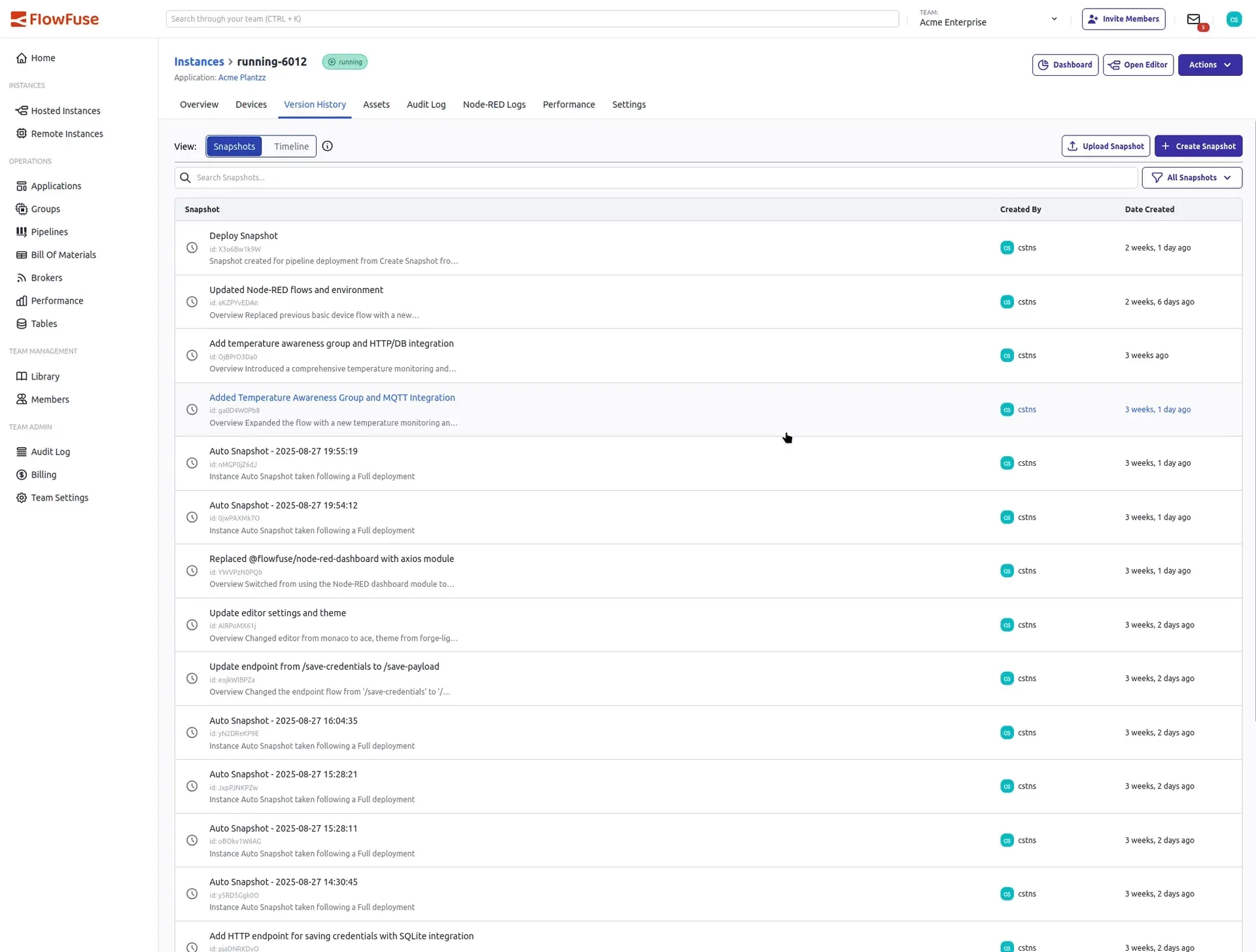
Streamlined snapshot management -
AI Snapshot Descriptions Now Work with Remote Instances
We've extended AI-generated snapshot descriptions to remote instances.
Whether your remote instance is linked to an application or a hosted instance, you can now generate a smart, clear description of the snapshot with a single click.
Two Flows, Same Outcome
Depending on how your remote instance is owned, the flow is slightly different:
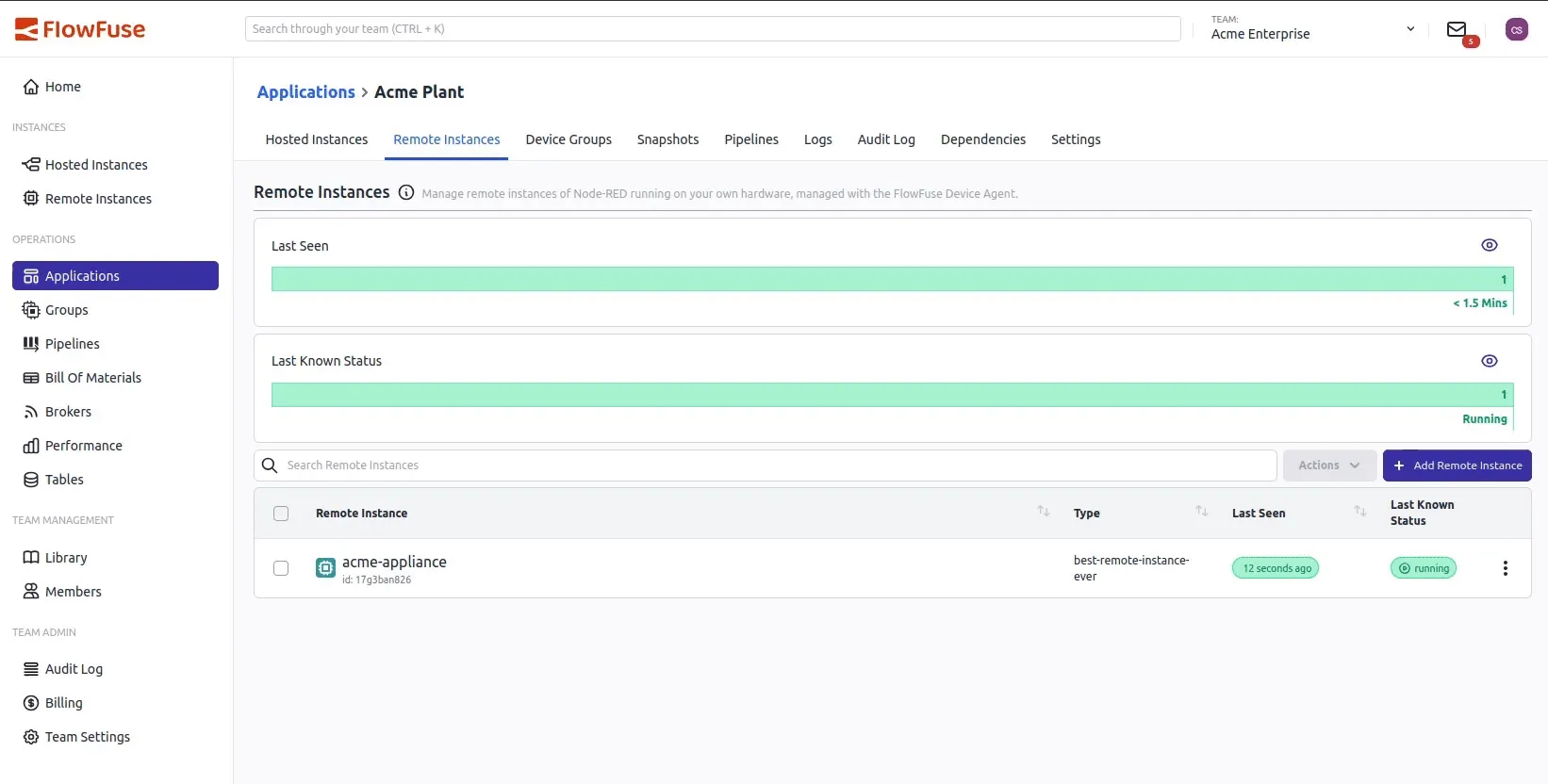
AI for application-owned remote instances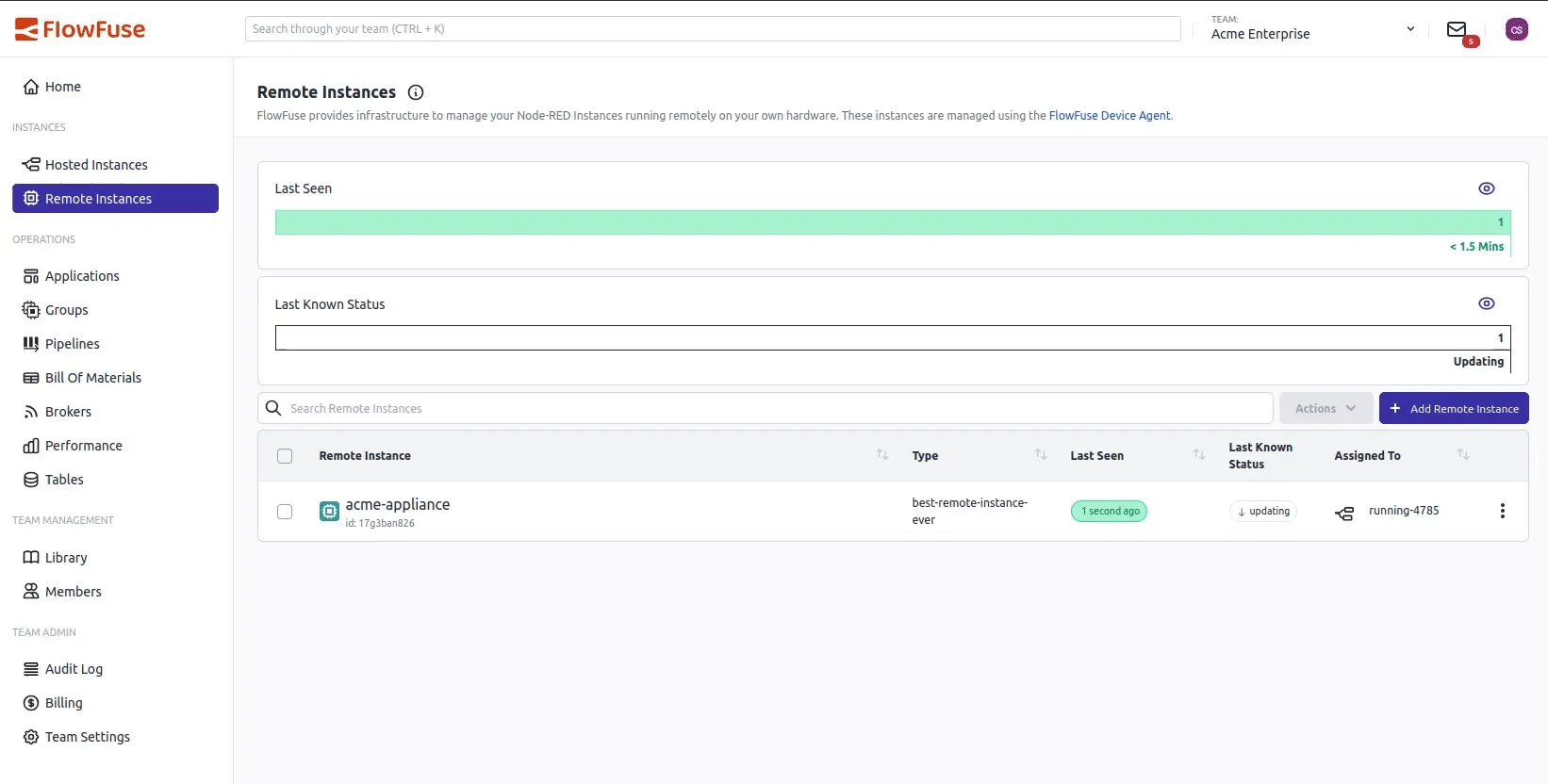
AI for hosted-instance-owned remote instancesThis rounds out our support for AI-generated snapshot descriptions.
-
FlowFuse Assistant can help you write code
More goodness has been added to the FlowFuse Assistant by way of inline suggestions as you type. Initially, we have added support for the Function Node, Tables Query Node and the Dashboard Template Node. It is contextually aware so will offer suggestions applicable to what it sees and what is already written.
Let's see it in action
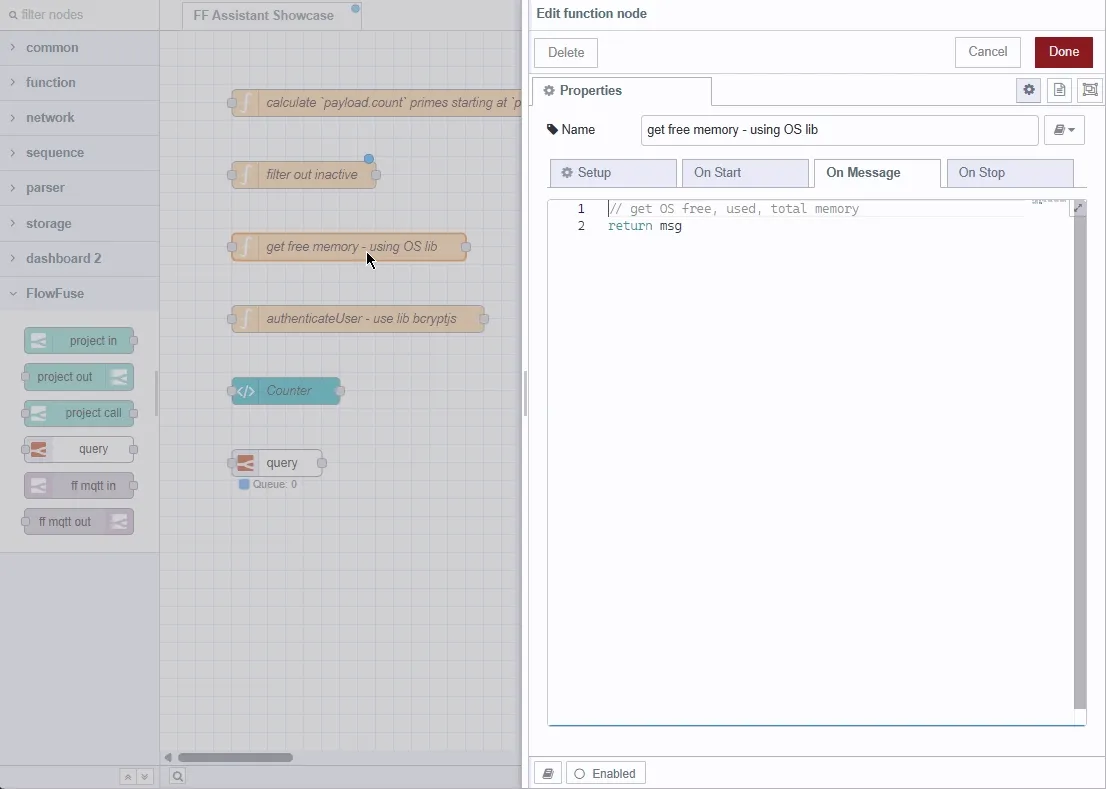
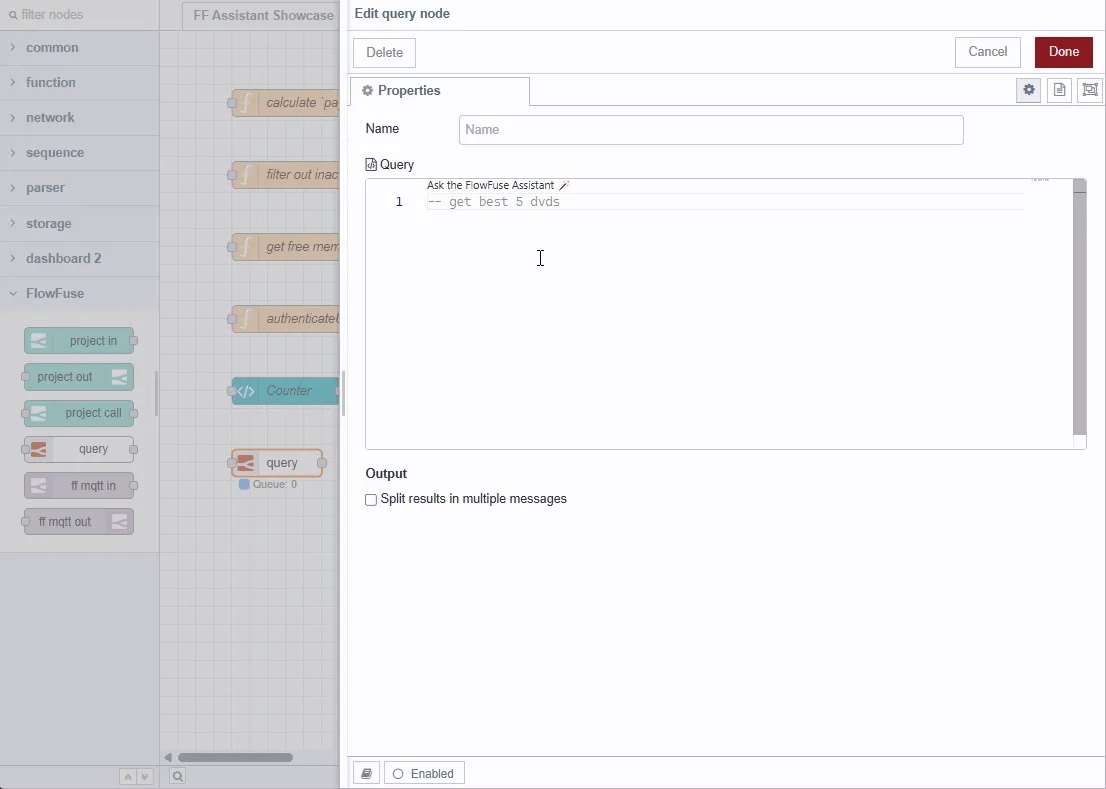
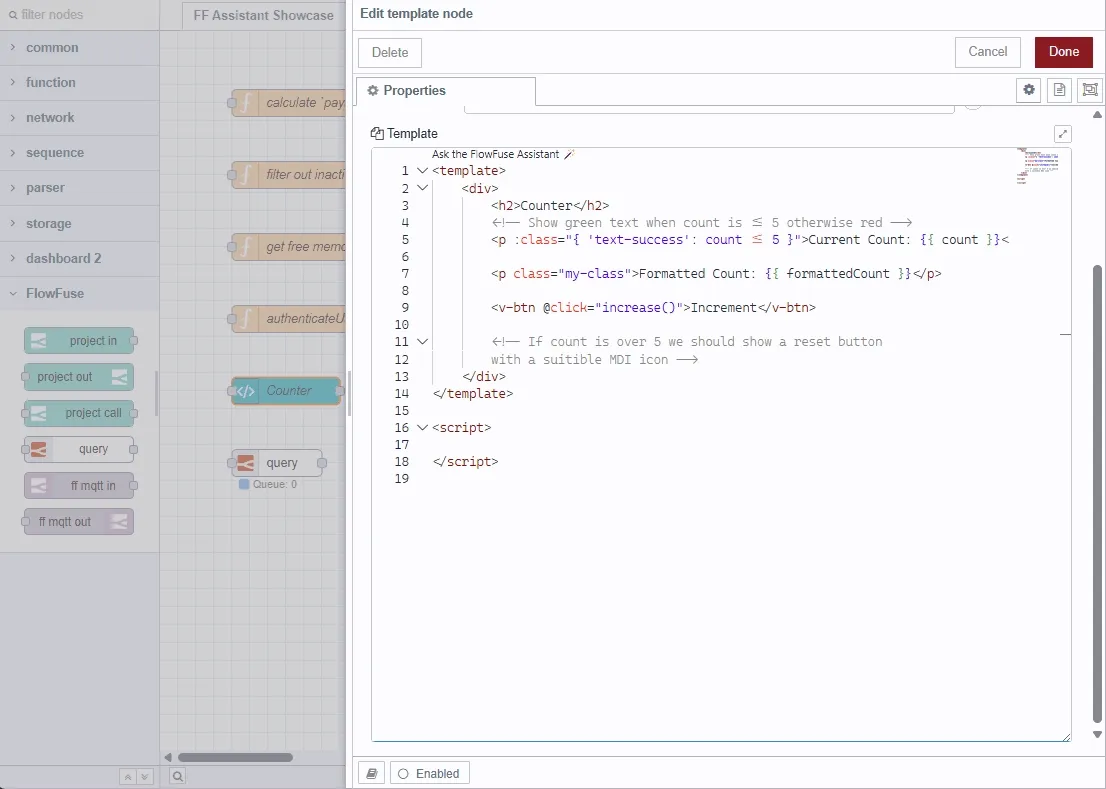
This will be made availabe to our Pro and Enterprise users in remote and hosted instances in the next update however if you want to give it a go right away, you can update the FlowFuse Assistant in the Node-RED Palette Manager today.
-
FlowFuse Remote Instance Performance Data
FlowFuse Device Agent version v3.6.0 combined with FlowFuse v2.21.0 allows you to monitor the CPU and Memory usage of Remote Instances
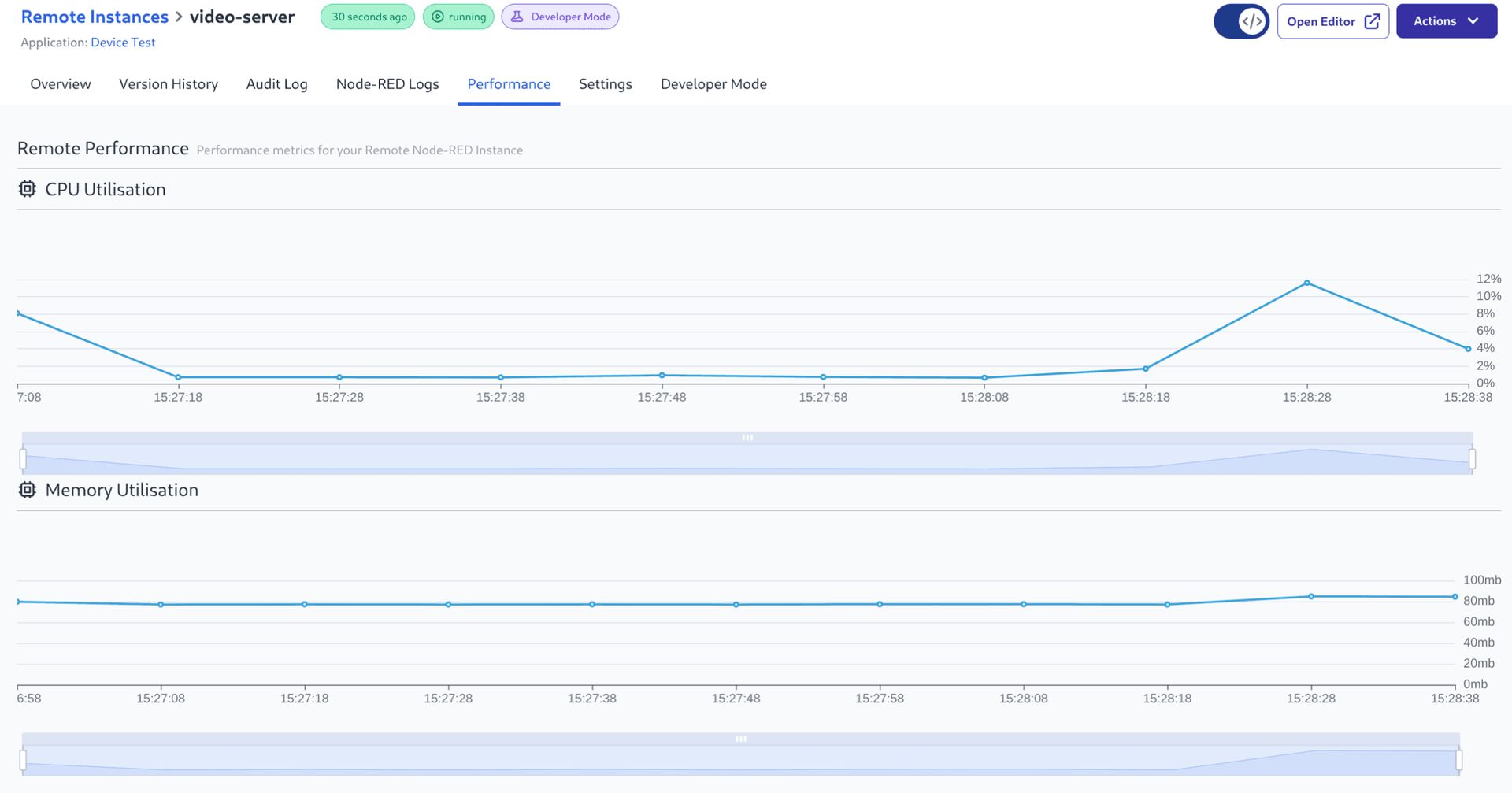
The view is available from the "Performance" tab on the Remote Instance page.
This feature is available to Enterprise customers on FlowFuse Cloud and to Enterprise licensed self hosting customers.
-
Export SubFlow as Node-RED module
Instances running the latest Node-RED version on FlowFuse v2.21.0 will now be able to export Node-RED SubFlows as Node-RED nodes.
This is done from the Node-RED editor using a custom sidebar.
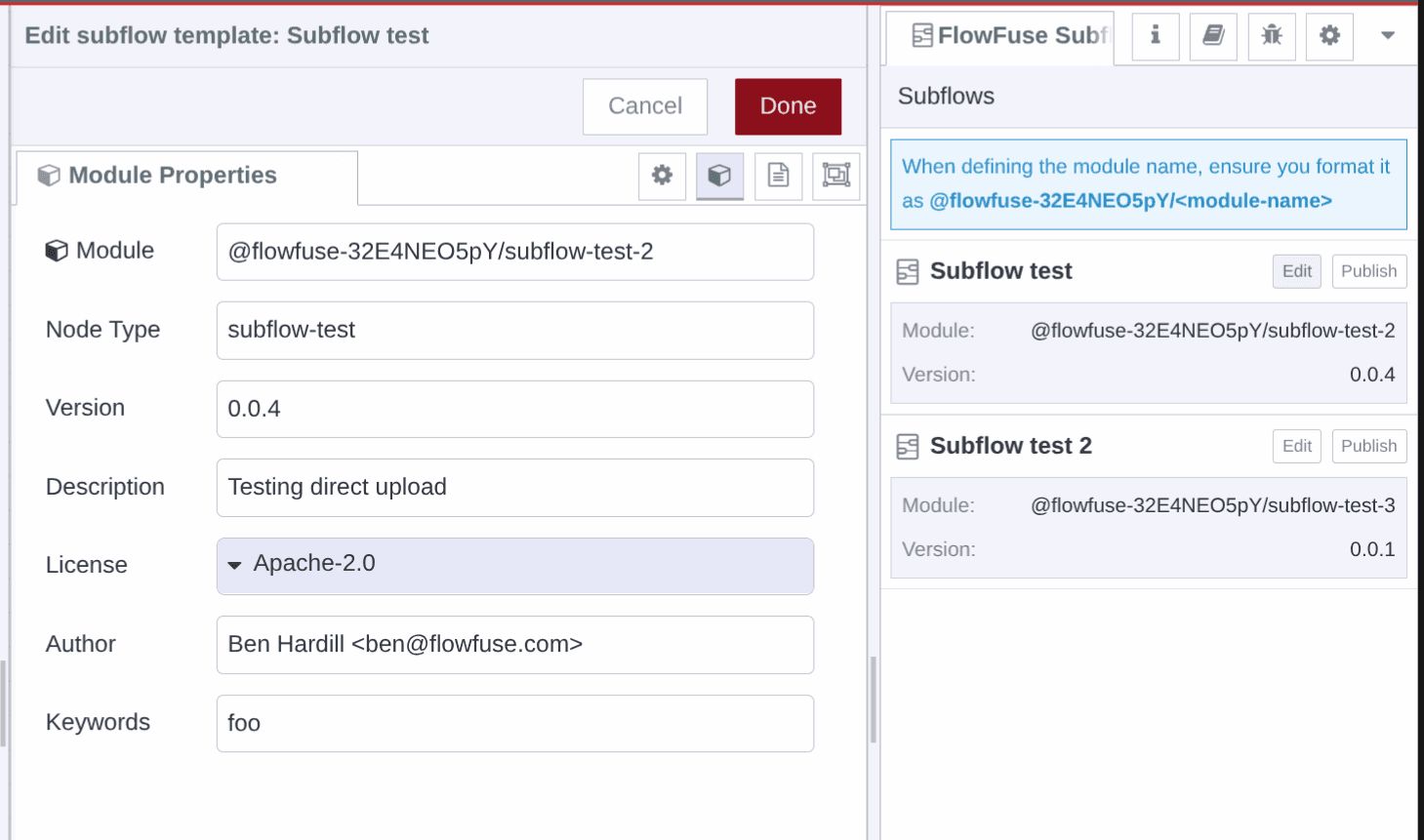
The nodes are added to the Team's Library of Custom Nodes and can be installed into any of the Team's Node-RED instances from the Catalogue generated by the Team Library.
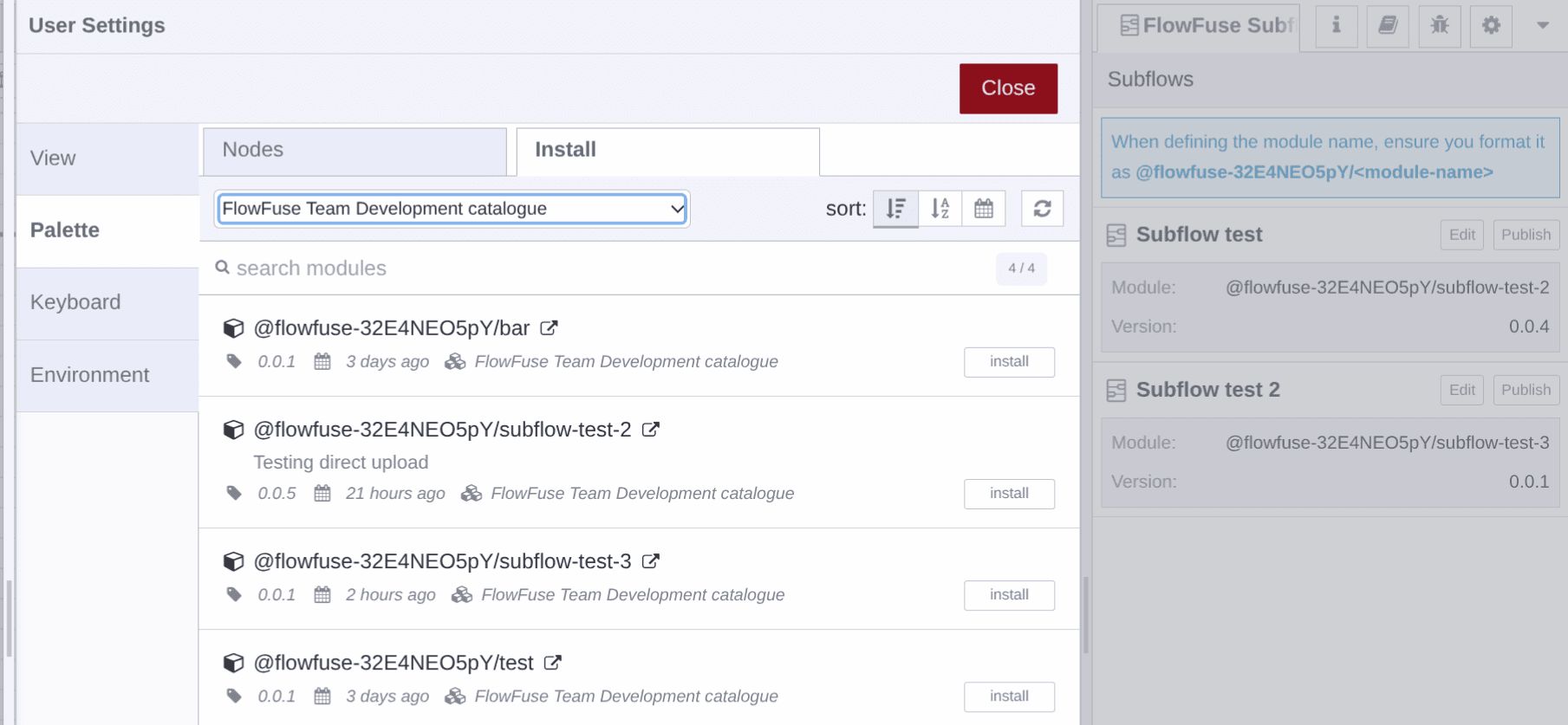
This feature is available to FlowFuse Cloud Pro and Enterprise teams and to Enterprise Self hosting users.
-
FlowFuse Tables with a little help from the Assistant
The new Tables we introduced in FlowFuse 2.20.0 feature may be still in Beta but to help you make the most of it we have added a codelens to the query editor to help you get your queries written faster.
Behind the scenes, when you ask for assistance, we gather schema info and include this in the process of making a prediction as to the best tables and fields to use for in the query.
Let's see it in action
